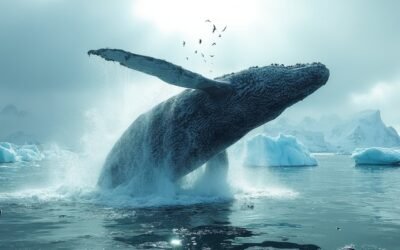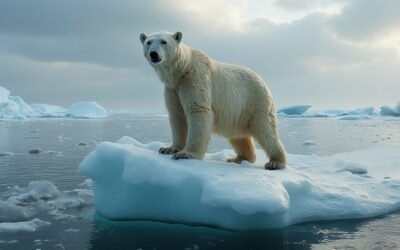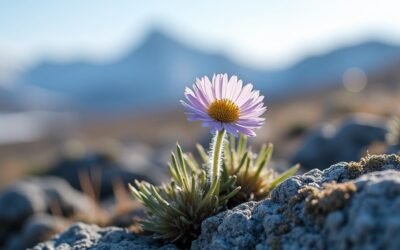The decline in the harp seal population in the Arctic is primarily due to climate change, which reduces sea ice cover essential for their survival. Diminishing ice affects breeding, molting, and increases pup mortality rates. Harp seals rely on stable ice platforms for these important life stages, and the ongoing loss of sea ice disrupts their natural behavior. Additionally, changes in prey availability and overfishing further threaten their population by affecting reproductive success and survival rates. In-depth conservation efforts, including habitat preservation and sustainable fisheries management, are necessary to mitigate these challenges. Learn about additional conservation strategies and impacts.
Main Points
- Melting sea ice reduces stable platforms needed for breeding and molting, increasing pup mortality rates.
- Rising global temperatures accelerate the decline of critical Arctic sea ice habitats for harp seals.
- Increased storm activity causes ice collapse, endangering seal pups and disrupting breeding grounds.
- Shifting prey availability and overfishing reduce key food sources, impacting harp seals' reproductive success and survival.
- Light ice years and negative NAO conditions lead to higher neonatal mortality and compromised breeding habitats.
Climate Change Impact
The impact of climate change on harp seals is primarily driven by the significant reduction in sea ice cover in the Arctic. As global temperatures rise, the Arctic experiences accelerated melting of sea ice, which directly affects the habitats critical for harp seals. These marine mammals depend on stable ice platforms for key life processes such as breeding and molting.
Warmer temperatures are causing rapid changes in the ice conditions, diminishing the availability of suitable ice for harp seals. This reduction in sea ice cover forces harp seals to travel greater distances to locate appropriate ice floes, adding physical stress and reducing their overall fitness. The increased energy expenditure and extended travel times can lead to higher rates of mortality within the population.
Furthermore, climate change-induced shifts in sea ice patterns are making it increasingly difficult for harp seals to find dependable breeding grounds. The instability and fragmentation of ice floes mean that young seals are at a greater risk of mortality due to drowning or predation. This elevated threat level exacerbates the population decline, with fewer young seals surviving into adulthood. The overarching influence of climate change is critically endangering harp seals through the continuous loss of their essential sea ice habitat.
Loss of Sea Ice
The decline in sea ice habitat due to rising temperatures poses a serious threat to the survival of harp seals in the Arctic. Reduced ice thickness and increased storm activity result in higher pup mortality rates and force seals to seek out alternative breeding grounds. Consequently, these changing ice conditions disrupt the natural behavior, reproduction, and overall survival of the species.
Declining Ice Habitat
Thinning sea ice in the Arctic since 1995 has greatly affected the survival rate of harp seal pups. The ice habitat, essential for the birthing and rearing of these marine mammals, has become increasingly unstable due to changing sea ice conditions. As a result, the declining population of harp seals is a growing concern for conservationists and researchers alike.
Fragile sea ice conditions have made it increasingly difficult for harp seal pups to find secure platforms for resting and nursing. During bad ice years, which have become more common, storms can cause the already weak ice to collapse, endangering young seals and increasing the likelihood of drowning. This instability requires the seals to swim longer distances to locate suitable ice, further straining their already vulnerable population.
Climate change is significantly adding to the loss of sea ice habitat, directly impacting harp seal populations in the Arctic. The reduction in stable ice not only threatens the immediate survival of seal pups but also disrupts the broader ecosystem dynamics. As the sea ice continues to thin, the future of harp seals remains uncertain, necessitating urgent action to address this environmental crisis.
Increased Pup Mortality
As sea ice continues to diminish, the mortality rate of harp seal pups has alarmingly increased due to the loss of stable birthing grounds. The decline in ice conditions has a direct impact on pup mortality, as harp seals rely on solid ice for birthing and raising their young. Light ice years, characterized by reduced sea ice cover, have been strongly linked to higher neonatal mortality rates among harp seals. This correlation underscores the critical role that stable sea ice plays in providing a secure breeding habitat.
The retrospective analysis indicates a significant annual decline in sea ice cover, which exacerbates the challenges faced by harp seal populations. The loss of ice habitat during pupping seasons severely affects the survival rates of young seals. As the climate continues to change, the breeding habitat for harp seals becomes increasingly compromised, leading to rising mortality rates.
Below is a table summarizing the key points:
| Factor | Impact | Result |
|---|---|---|
| Decreased Sea Ice Cover | Unstable birthing grounds | Increased pup mortality |
| Light Ice Years | Higher neonatal mortality | Reduced young seal survival |
| Annual Ice Decline | Habitat loss | Compromised breeding habitat |
| Climate Change | Altered ice conditions | Higher seal mortality |
| Pupping Season Impact | Loss of ice habitat | Lower survival rates |
The ongoing reduction in sea ice poses a significant threat to harp seal populations, necessitating urgent attention and action.
Shifting Breeding Grounds
How has the relentless decline in Arctic sea ice forced harp seals to shift their breeding grounds, thereby endangering their reproductive success? The reduction in sea ice coverage, primarily driven by climate change, is altering the distribution and habitat availability for harp seals. These marine mammals depend on stable sea ice for essential activities such as breeding, nursing, and molting. As the extent of ice diminishes, the availability of suitable pupping grounds in the Arctic is severely compromised.
Harp seals require firm, consistent ice platforms to safely give birth and nurture their pups. The loss of sea ice forces seals to relocate to less ideal breeding grounds, where the ice is often thinner and more unstable. This shift negatively impacts their reproductive success, as pups are more vulnerable to drowning or predation when the ice breaks apart prematurely.
Furthermore, changes in sea ice conditions affect the broader ecosystem, influencing food availability and the survival rates of harp seal pups. The urgency for effective conservation efforts cannot be overstated, as continued ice loss threatens the long-term viability of harp seal populations. Addressing these changes is essential for ensuring the species' survival amid a rapidly changing Arctic environment.
Breeding Challenges
Breeding challenges for harp seals have intensified due to the rapid deterioration of sea ice in the Arctic. The decline in ice coverage disrupts traditional breeding areas, creating unfavorable environmental conditions. Harp seals rely on stable sea ice to give birth and nurse their pups, but the warming winters driven by climate change have markedly reduced ice stability and thickness since 1995.
The following table illustrates key factors affecting harp seal breeding:
| Factor | Impact | Consequence |
|---|---|---|
| Ice Coverage | Reduced | Less stable breeding areas |
| Environmental Conditions | Warming winters | Thinner ice |
| Ice Stability | Decreased | Increased risk of collapse |
| Storm Frequency | Higher | Ice fragmentation |
| Breeding Success | Lower | Higher pup mortality rates |
Weak ice is more susceptible to collapsing during storms, which can result in high mortality rates among seal pups due to drowning. The changing ice conditions also compel harp seals to travel greater distances to locate suitable breeding areas, further impacting their reproductive success. As ice continues to deteriorate, the survival of harp seal populations faces increasing jeopardy, with the current environmental trajectory posing noteworthy long-term risks. Addressing these challenges requires a thorough understanding of the interplay between climate change and sea ice dynamics to develop effective conservation strategies.
Food Scarcity
Food scarcity emerges as a critical factor contributing to the decline of harp seals in the Arctic, primarily due to changing prey availability and overfishing. The decline in populations of fish such as capelin, herring, and polar cod, alongside shifts in krill and amphipods abundance, has notably affected harp seals' primary food sources. These changes, driven by environmental shifts and the overexploitation of prey species, have led to a substantial reduction in the food resources necessary for the survival and growth of harp seal populations.
Changing Prey Availability
Changes in prey availability are an essential factor contributing to the population decline of harp seals in the Arctic. These marine mammals rely on a diet consisting primarily of capelin, polar cod, herring, krill, and amphipods, all of which are subject to fluctuations. Such variations in prey abundance directly impact the reproduction success and survival of harp seals.
As the Arctic ice cover changes, there is a notable shift in prey species composition—from crustaceans to fish. This shift not only influences the feeding habits of harp seals but also affects their energy storage, which is vital for sustaining them during extreme cold periods. Environmental changes in the North Atlantic, including those caused by fluctuating temperatures and altered ice conditions, further exacerbate the scarcity of prey.
The harp seals demonstrate some adaptability by seeking different prey in various regions during summer and fall. However, this ability to cope with food scarcity is not always sufficient to offset the negative impacts on their population. The cumulative effect of these changes in prey availability is a significant contributor to the observed decline in harp seal populations, highlighting the intricate connection between ecosystem health and species survival in the Arctic.
Overfishing Impacts Ecosystem
Overfishing in the Arctic has greatly disrupted the marine ecosystem, leading to a significant reduction in key prey species essential for the survival of harp seals. Species such as capelin and polar cod, which form a substantial part of the harp seal's diet, have seen substantial declines due to overexploitation by commercial fisheries. This reduction in prey species has created food scarcity, severely impacting the reproductive success and population dynamics of harp seals.
The diminished availability of prey affects the energy stores of harp seals, resulting in poorer body condition and lower survival rates. This disruption in the ecosystem balance reverberates through the Arctic food web, influencing not only harp seals but also other predators dependent on similar prey. The overall health of harp seal populations is jeopardized as their nutritional intake becomes insufficient to meet their physiological needs.
Addressing the overfishing issue through sustainable fisheries management is essential to restoring the ecosystem balance and ensuring an adequate food supply for harp seals. Implementing measures to regulate fishing practices can help mitigate the impact on prey species and support the recovery of harp seal populations. Sustainable management practices are vital for the long-term conservation of the Arctic marine ecosystem.
Increased Mortality Rates
Climate change-induced declines in sea ice cover are noticeably increasing mortality rates among harp seals in the Arctic. The shrinking sea ice cover, essential for harp seal breeding, forces seals to give birth on unstable ice, leading to higher neonatal mortality rates. During light ice years, combined with negative North Atlantic Oscillation (NAO) conditions, the survival rates of young seals plummet, as they are more vulnerable to drowning or being crushed by collapsing ice.
Historical data reveals that during these light ice years, harp seals are often compelled to leave their birthing areas prematurely, significantly impacting their chances of survival. The reduced sea ice cover across breeding regions is a significant driver of increased mortality within the species. The environmental shifts, primarily fueled by climate change, disrupt the delicate balance of harp seal population dynamics.
These changes not only affect the immediate survival of seal pups but also have long-term repercussions on the overall population structure. The increased mortality rates caused by diminishing sea ice highlight the importance of addressing climate change to preserve the delicate Arctic ecosystem and the species that rely on it.
Conservation Efforts
Conservation efforts for harp seals focus on rigorous population monitoring, habitat preservation, and collaborative research to mitigate the impacts of environmental changes and human activities. Researchers conduct surveys every 4-5 years using aircraft and helicopters to assess harp seal populations. These surveys provide vital data on population dynamics and reproductive rates, informing conservation strategies.
Severe storms and poor ice conditions pose significant challenges to these efforts, making it difficult to accurately monitor and protect harp seals. Despite these obstacles, conservation initiatives aim to safeguard harp seals and their habitats, ensuring their long-term viability in the face of climate change and human impacts. Collaborative efforts between researchers and conservationists are essential for the survival and protection of harp seals.
Key components of current conservation efforts include:
- Population Monitoring: Regular aerial surveys to track population dynamics and reproductive rates.
- Habitat Preservation: Protecting critical habitats to mitigate the effects of habitat changes and environmental stressors.
- Collaborative Research: Partnerships between scientists and conservation organizations to share data and develop effective strategies.
- Addressing Climate Change: Implementing measures to combat the impacts of climate change on ice conditions and seal habitats.
These concerted efforts are crucial to counteract the factors contributing to the decline of harp seal populations in the Arctic.
How Does the Harp Seal Migration Impact Their Population Decline in the Arctic?
Arctic harp seal migration plays a significant role in their population dynamics as changing ice conditions in the Arctic challenge their natural habitat. Rising temperatures reduce the availability of stable sea ice, crucial for giving birth and nursing pups, leading to higher mortality rates and long-term population decline.
What Are the Main Factors Leading to the Decline in Harp Seals Population in the Arctic?
Climate change is a major contributor to harp seals population decline. The melting sea ice in the Arctic limits essential birthing and nursing areas for harp seals, impacting survival rates. Overfishing also reduces their primary food sources, further exacerbating the species’ vulnerability in the face of environmental changes.
Conclusion
The decline in the harp seal population in the Arctic is primarily driven by climate change, resulting in significant loss of sea ice. This loss disrupts breeding and increases mortality rates. Additionally, food scarcity exacerbates the challenges faced by these seals. Conservation efforts are crucial to mitigate these impacts and safeguard the survival of the species. Immediate action is required to address the multifaceted threats posed by a changing climate and secure the long-term viability of harp seal populations.


